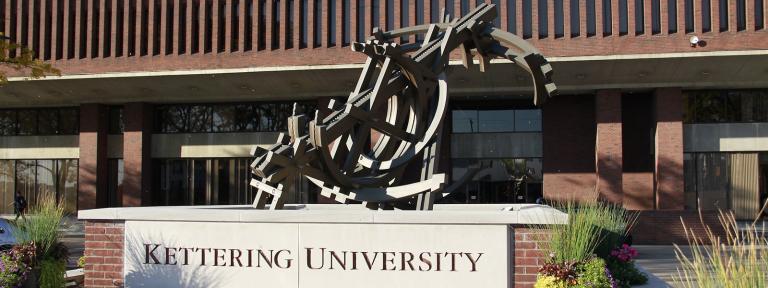
The historical documentation of one of the world's most prominent automotive corporations has once again found a permanent home at Kettering University.
Kettering's Scharchburg Archives has gained even more prominence with the addition of the papers of F. James McDonald '44, 16th president of General Motors Corp.
The papers record his illustrious 47-year career and trace the corporation's evolution from a national corporation to a global automotive power. In addition to this contribution, McDonald gave Kettering $50,000, which, according to Archivist David White, will help preserve the collection through the purchase of acid free papers and material used to properly display the historical documents in a permanent fashion.
"Mr. McDonald's gift is a great collection from both an industrial and university point of view," said White. "He is a very down-to-earth man, and I believe his collection shows just how far hard work and determination can take one in their career."
This contribution marks the fourth time Kettering's Scharchburg Archives received a donation of papers from a former president of GM. Other presidential papers housed in the Scharchburg Archives include William C. Durant, Harlow Curtice and Elliot "Pete" Estes, a 1939 graduate of GMI.
F. James McDonald '44
The theme of hard work and determination is clearly evident in the biographical details of McDonald's hallmark career. Born in Saginaw, Michigan, Aug. 3, 1922, he grew up in an Irish Catholic family and attended St. Andrew's elementary and secondary schools, where he displayed a natural talent for mathematics and science, as well as a penchant for football and hockey.
Following his graduation from St. Andrew's High School in 1940, he joined GM as a student at General Motors Institute (GMI) sponsored by the Saginaw Malleable Iron Plant. He graduated from GMI in 1944 and served in the Navy as an engineering officer assigned to the submarine service.
After the war, McDonald returned to the Saginaw Malleable Iron Plant as a draftsman but soon requested a transfer to the plant floor to, as he put it, "be closer to the action." This transfer sparked what would become one of the most descriptive elements of his GM career. During his time on the plant floor, he perfected a new conveyer-belt system, which helped seal his reputation as a troubleshooter and innovator.
In April 1955 at the age of 32, he was named plant manager at one of GM's largest foundries in Defiance, Ohio. This assignment began what Archivist David White described as a "steady rise upward that included general manager positions at Hydra-matic, Pontiac Motor and Chevrolet Divisions in 1963, 1969 and 1972."
The Pontiac post exposed McDonald to the "wheels end" of the business and further prepared him for his eventual leadership of GM. He was named a GM vice president.
In 1974, he was appointed to the board of directors and made executive vice president of Truck, Body and Assembly, and Electrical and Mechanical Components Groups. Soon afterward he earned the top post at the corporation as president and chief operating officer in 1981, succeeding Elliot "Pete" Estes '39.
White said that perhaps one of the most notable aspects of McDonald's career was his strong support of the union and corporate efforts to improve the quality of work at GM. "During his presidency, his administration instituted a living document that included six mandates that identified quality as the top operating priority throughout the corporation," he said.
Under McDonald's leadership, GM instituted a reorganization of American vehicle operations that McDonald believed "were absolutely necessary for GM to compete in the global market."
White also noted that this collection is critical in preserving the history of one of America's most important companies. "These papers will be invaluable to researchers who wish to tell the story of General Motors," he said. "It is an excellent reflection of the changes that occurred at GM in the 1980s as they prepared for a global market. Most importantly, this collection is an illustration of the American Dream because it shows how Mr. McDonald, using his GMI education while employed in the foundry, rose to the top of one of the world's largest corporations."
And as a long-time supported of his alma mater, McDonald explained that this collection represents an important link to the history of GM and those who helped shaped the company into what it is today. "It is important to me to save our history," he said.